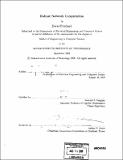Robust network computation
Author(s)
Pritchard, David (David Alexander Griffith)
DownloadFull printable version (4.799Mb)
Other Contributors
Massachusetts Institute of Technology. Dept. of Electrical Engineering and Computer Science.
Advisor
Santosh S. Vempala.
Terms of use
Metadata
Show full item recordAbstract
In this thesis, we present various models of distributed computation and algorithms for these models. The underlying theme is to come up with fast algorithms that can tolerate faults in the underlying network. We begin with the classical message-passing model of computation, surveying many known results. We give a new, universally optimal, edge-biconnectivity algorithm for the classical model. We also give a near-optimal sub-linear algorithm for identifying bridges, when all nodes are activated simultaneously. After discussing some ways in which the classical model is unrealistic, we survey known techniques for adapting the classical model to the real world. We describe a new balancing model of computation. The intent is that algorithms in this model should be automatically fault-tolerant. Existing algorithms that can be expressed in this model are discussed, including ones for clustering, maximum flow, and synchronization. We discuss the use of agents in our model, and give new agent-based algorithms for census and biconnectivity. Inspired by the balancing model, we look at two problems in more depth. (cont.) First, we give matching upper and lower bounds on the time complexity of the census algorithm, and we show how the census algorithm can be used to name nodes uniquely in a faulty network. Second, we consider using discrete harmonic functions as a computational tool. These functions are a natural exemplar of the balancing model. We prove new results concerning the stability and convergence of discrete harmonic functions, and describe a method which we call Eulerization for speeding up convergence.
Description
Thesis (M. Eng.)--Massachusetts Institute of Technology, Dept. of Electrical Engineering and Computer Science, 2005. Includes bibliographical references (p. 91-98).
Date issued
2005Department
Massachusetts Institute of Technology. Department of Electrical Engineering and Computer SciencePublisher
Massachusetts Institute of Technology
Keywords
Electrical Engineering and Computer Science.